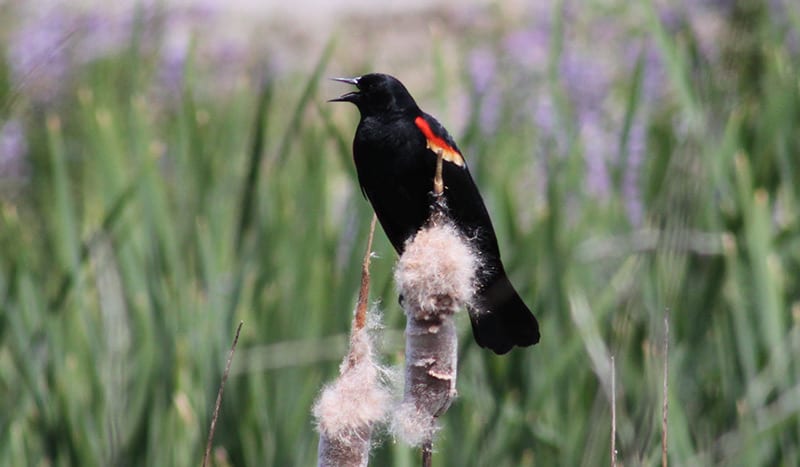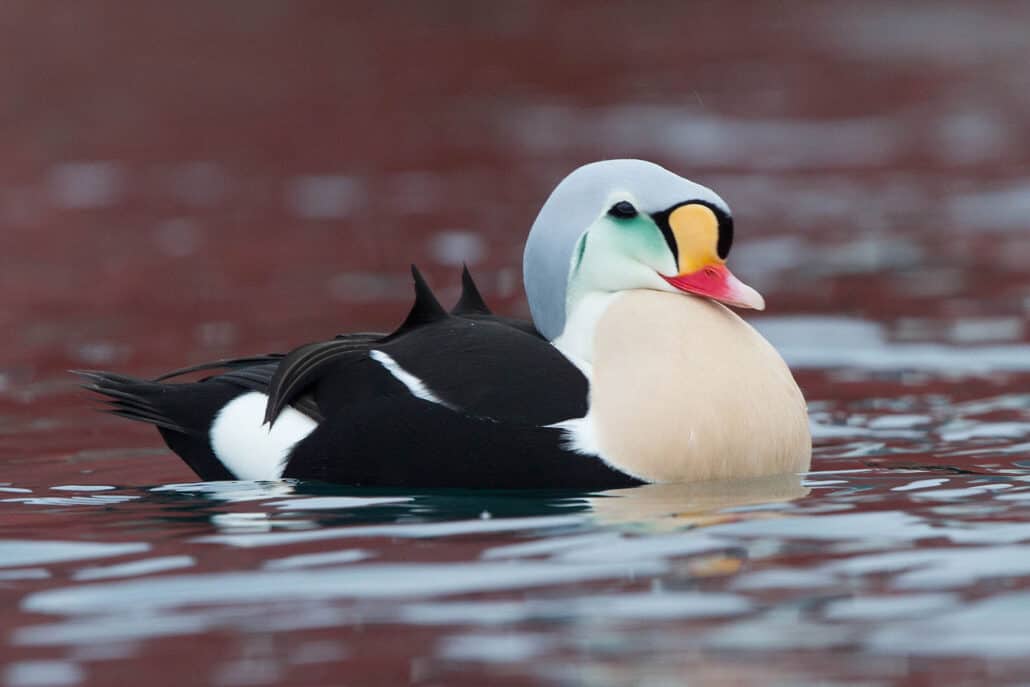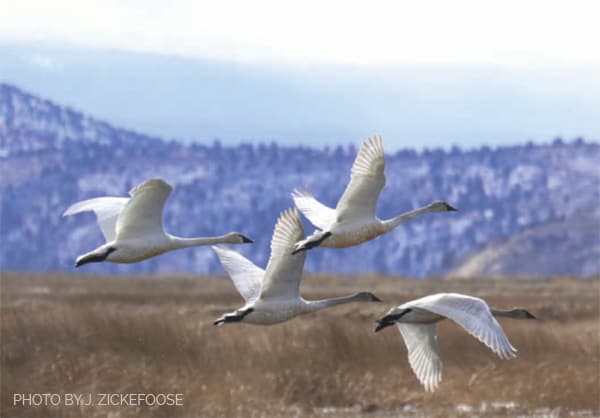Spring Birds of Wisconsin (March, April, May)
In some ways, springtime in Wisconsin is like that one relative found in many families: the one who frequently shows up late, sometimes makes a scene, but who bears such charm and gifts that all is forgiven.
In fact, some might argue that springtime in Wisconsin is an oxymoron. Late March and April snowfall is common, but does not deter hardy plants—and bird watchers—from seeking the sun. In white cedar swamps, skunk cabbage pokes through the snow, soon to loose its large furled leaves. Delicate pasque flowers hug the soil in Wisconsin’s prairie remnants, providing another welcome sign of spring. Bloodroots appear along roadsides and trails, while hepaticas and Dutchman’s breeches bloom in woodlots. Maples put out tiny greenish-yellow flowers, yet another sign that winter has relinquished its hold.
While many consider robins to be the state’s official harbingers of spring, other species compete for the title. Red-winged blackbirds return to Wisconsin in late February and early March, singing their cong-la-REE as they gather in large numbers in area wetlands. Soon, the cattail marshes are alive with sound, as chorus frogs join the symphony. By early May, the descending whinny of soras can be heard, a call easy to remember once you’ve had it identified. Soras belong to the rail family, a family of marsh-loving birds, and are much more often heard than seen. If you’re patient, you may catch a glimpse of the small, plump bird as it works its way through the reeds.
White-throated sparrows announce their early spring arrival with a persistent Old Sam Peabody, Peabody, Peabody. You will often find them kicking aside leaves in search of seeds. In residential areas, they are sometimes joined by white-crowned sparrows, handsome birds with black-and-white striped crowns and pinkish bills. White-throats nest in the spruce bogs of northern Wisconsin, while white-crowns pass through the state on the way to their breeding grounds farther north.
In early spring, many Wisconsin bird watchers direct their attention to the flooded farm fields dotting the landscape, where a quick stop along the road may yield views of blue- and green-winged teal, shovelers, and other waterfowl. Shorebirds such as yellowlegs, killdeer, and black-bellied plovers are sometimes found working the edges of these temporary ponds.
Although snow may still cover the ground, spring—and romance—are definitely in the air. In late March to early April, American woodcocks put on aerial shows with their “sky dances” throughout the state. Bird watchers gather at dusk to observe the males in their twisting flight displays, performing in what Aldo Leopold described as an “open amphitheater of wood or brush.” The long-billed lothario leaps from the chosen spot and spirals upward in widening circles, his flight feathers making a twittering noise as he ascends. At about 300 feet he bursts into a chirping song and drops to the earth, swinging like a pendulum in his descent.
Around the same time of the woodcocks’ sky dances, bird watchers huddle in a small blind on the Buena Vista Marsh near Stevens Point, eagerly awaiting the early morning show: the arrival of greater prairie chickens on their booming grounds. Male prairie chickens inflate the orange sacs on their necks and perform a courtship dance, then deflate the sacs and make an oboe-like sound. Competing males also charge one another with their neck tufts erect and sacs inflated, adding to the action.
Although Buena Vista is no longer a marsh, having been drained about one hundred years ago, the area is one of the few places in the state to see prairie chickens at close range. About half of the state’s estimated 1,000 prairie chickens live in Buena Vista. Thanks to the dedicated efforts of Frances and Frederick Hamerstrom, who studied the birds for decades, a decline in the species’ population was reversed. More than 14,000 acres of prairie chicken habitat in central Wisconsin was purchased between 1957 and 1971, providing grassland habitat to support a stable population. A recent DNR proposal recommends purchasing up to 15,000 additional acres in the central sands region of the state.
Across the state at Crex Meadows Wildlife Area, sharp-tailed grouse gather on their dancing grounds, which are called leks. Males “flutter-jump” and dance in small arcs, with tail feathers clicking and violet neck pouches inflated.
While prairie chickens and grouse strut their stuff, volunteers from throughout the state track numbers of a different species. The Annual Midwest Crane Count is among the largest single species inventories in the world. Organized by the International Crane Foundation in Baraboo, the first Crane Count was conducted in 1976, and now tallies birds by county in Wisconsin and portions of Michigan, Illinois, Iowa, and Minnesota.
Long-necked, long-legged birds are not the only ones garnering attention. Spring migration brings large numbers of colorful songbirds to the state. Diminutive golden-crowned kinglets show up in conifers in southern counties by mid-March Extremely active birds, they flit from branch to branch as they feed on insects. The bright “golden” crown patch is actually orange on males and yellow on females. Golden-crowns also have distinctive white eyeline bordered by black.
Among warblers, yellow-rumps are usually the first to arrive. Wisconsin’s most abundant warbler, these “butter butts” usually reach the state’s southern counties by the first week in April. By early May, a host of warblers are doing their version of the “wave” throughout the state, often coming in with a weather system and delighting bird watchers with daily totals of fifteen or more species in one fallout day. Many nature centers and birds clubs sponsor bird hikes during this time of peak migration, often in observance of International Migratory Bird Day.
Baltimore orioles traditionally arrive around Mother’s Day, often appearing in residential areas around the state. Males arrive first with a definite flair, brightening treetops and singing loudly. Many bird watchers get close looks at these colorful birds by attracting them to feeders holding orange halves. The orioles soon begin building their pendular nests in shade trees, often returning to the same site year after year.
Construction season is in full swing for many species as spring draws to a close. Robins and red-winged blackbirds, those heralds of spring, join others of the state’s breeding birds to raise their young as the days lengthen and temperatures warm.




